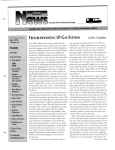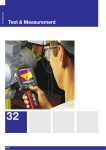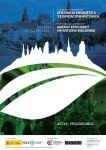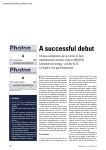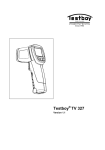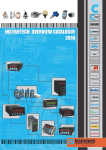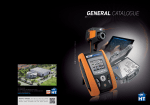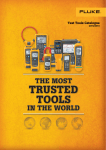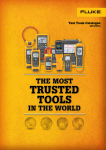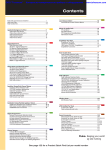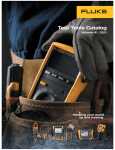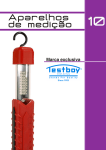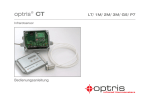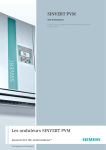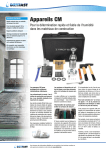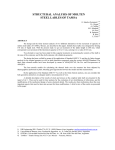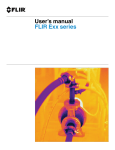Download Thermography cameras survey
Transcript
science & technology | thermography cameras | survey & test More than pretty pictures Text: Juliane Hinz, Anne Kreutzmann, Jochen Siemer Highlights • PHOTON Lab has put a number of thermography cameras to the test • Of the 14 cameras tested, eight achieved a grade of »B«, two a »C« and two received a grade of »E« • Three cameras were tested non-competitivelywithout assigning a grade, because they did not fit all of our criteria • Anybody who is considering purchasing a thermography camera should first clarify exactly how it will be used. Not every »B« grade camera we tested is equally good for every application 60 Thermography camera makers and suppliers are discovering solar installers as a customer group. Most of the cameras we tested passed with a »B« grade; but there are considerable differences among them when it comes to features and user-friendliness T hermography cameras are enjoying increasing popularity among solar installers – and rightly so, as our overview and testing demonstrate. Less than 5 years ago, a usable thermography camera still cost over €50,000 ($68,350) – and installers deployed them as technical aids with an infrequency commensurate with their price. Since then, however, a whole slew of decent cameras have become available for under €10,000 ($13,670). Furthermore, camera manufacturers have discovered solar installers as an attractive customer base and have adapted their product lines to this new niche market. This is necessary because requirements in the solar industry are different from those in. the building sector. Testo AG, for example, offers a special solar mode for its thermal imagers (see also the test report in online edition on p. 138*). Which camera is the best choice in each case, however, depends primarily on how it will be used. A small, inexpensive camera is adequate for detecting faults in entire strings (caused by shading or bad connections), whereas a model in the middle of the range would additionally be able to identify hot bypass diodes. If you also want to be able to detect cracks in cells and hot spots as small as a square centimeter, you will need a camera with resolution of at least 640 × 480 pixels, which, however, will cost well over €10,000 ($13,671). For example, the VarioCAM hr inspect 600/700 Series from Jenoptik AG, which boasts that kind of resolution, goes for €18,950 (net) ($25,906). And from there upward, there is hardly any limit on how much you can pay. For a solar installer who just wants to check his modules quickly, or somebody working for insurance compaJanuary 2014 We tested 14 thermography cameras for this overview. The champion is the Testo 885 with optional »SuperResolution«, which PHOTON Lab’s Juliane Hinz is holding in her hands. Frank Schuberth / photon-pictures.com (2) The CS 110 from Dias Infrared GmbH served as the calibration source for the test. nies and who often inspects large installations (and whose reports should be able to stand up in court if necessary), a lower resolution is sufficient. The installer would probably even be well served with the inexpensive i7 from Flir Systems GmbH (even though the manufacturer expressly states that this camera is not intended for use with PV), whereas the engineer working for an insurance would do better with a Testo 890. January 2014 Resolution isn’t everything, however. Different cameras may have the same resolution, but where one can distinguish certain structures, the other cannot. Also important to consider when selecting a camera are its features: Does the camera allow for manual focusing? How about auto focus? Does it have an adaptor for attaching it to a tripod? There are big differences among brands when it comes to accessories, as well. It can make sense to start with the base model of an inexpensive camera and then buy additional, interchangeable lenses later when the need arises (and money is available). Since lenses with continuously variable focal length (zoom lenses) do not work with thermography cameras, interchangeable lenses are the best way to adapt your thermal imaging camera to frequently changing situations or to expand your range of application over time. The ideal is, 61 science & technology | thermography cameras | survey & test This thermal image was used in a magazine article entitled »Massive Bungling of Solar Installations«. But what does the image really show? We see a picture of a barn roof with an incomplete PV installation. We can clearly make out the roof shingles around the edges, as well as the missing modules on the lower right side of the roof. A spot in front and to the left looks like the coolest area, which could be due to the fact that it’s facing downwind. The numbers and crosses are unusual in a thermal image and may have been caused by an imaging or exporting error. Furthermore, the distance to the object is too great. The red dots are very noticeable, but to hazard a guess as of course, to combine interchangeable lenses with higher detector resolution. The range of available accessories can thus definitely become a criterion when deciding which camera to buy. Fluke Corp., for example, offers quite a small selection of accessories, which (at least on their website) we also found a bit confusing. Competitor Flir, on the other hand, has a rich assortment of accessories that are clearly presented on its website, so you can find what you want easily. More choices Our current market overview lists 34 thermography cameras (including those we tested), of which five are priced over €10,000 ($13,670). This means that there are more cameras than ever to choose from (see table, p. 70 - 83). Despite the wide-ranging prices of cameras in the market overview, all of the devices listed there are actually in the lower price segment: Thermography cameras designed for scientific or military use have infrared light sensors and employ expensive, sensor-cooling technology. Such devices cost tens of thousands of euros, 62 Nbay-Energie.de Caution when interpreting thermal images to their cause from afar and without additional information would be inappropriate. The dots could be a symptom of poor installation, but they could also be shadows cast by dirt that have led to localized hot spots. In any event, so unless you have money to burn, you do not need to consider them. Moreover, for the needs of a solar installer, they are really overkill. The inexpensive mobile devices listed in the overview, on the other hand, employ microbolometers, i.e. thermal resistors, as detectors. These measure infrared radiation indirectly. Another important thing to consider in a camera is its resolution: At prices of €10,000 ($13,670) and below, resolution reaches up to 320 × 240 pixels. We set a minimum detector resolution of 120 × 120 pixels as a requirement for inclusion in the overview. Good soft ware is at least as important as a good camera, and in this area there were big distinctions among the various cameras. The most convenient software we tried is one currently being offered as an option by Flir called Reporter 9.0 (which, however, PHOTON Lab did not try out during testing, since for that purpose we always use the standard soft ware version rather than any optional soft ware). For €250 ($342) extra, you get reporting soft ware that uses templates, which means if s need to take new measurements on an installation, you do not have to compile a whole new report. You can save we cannot make a diagnosis of »bungling« on the basis of this image alone since many of the contextual parameters are missing -the general weather data and environmental conditions, the temperature scale (do the false colors represent temperature differences of 2 or 20 K?), the camera inputs (e.g. emissivity), the true-color visual image for purposes of comparison (e.g. to recognize dirt) as well as information about the condition of the installation: Is it still under construction and therefore not connected? All of these unanswered questions mean that, for the reader of the article, the colorful photo really serves no purpose other than decorative. jhz previously compiled reports and use them as templates for other reports. The soft ware automatically inserts the new thermal images in the existing report, and the analysis tools process the new data. The soft ware supposedly utilizes the full functionality of Microsoft Word and also employs additional tools for creating panorama images as well as videos from image sequences. The trick to getting good images »The biggest mistake a user can make is to take a blurry image,« says Michael Büttner from Testo AG. »If the measurement range has been correctly set and the image is sharp, all is well.« That may sound like a simple formula, but it does the trick. »Other factors, such as emissivity, can be set later in the soft ware,« he says. As you can see, it can’t hurt to become a little familiar with the technical aspects of thermal imaging. You should know, for example, the emissivity of the surface you are imaging, i.e. its ability to emit radiation (which also always depends on the viewing angle). The challenge lies in the fact that emissivities January 2014 Selection criteria The number and variety of thermography cameras available on the market today has made the selection process even more confusing than it was the last time PHOTON Lab compiled this market overview (the previous survey was only published I our national editions). These helpful instruments are employed in any number of fi elds, be it medicine, research or the construction industry. We must therefore ask ourselves what the requirements are for thermography cameras used in the fi eld of PV. In the end, we decided to stick with the criteria PHOTON Lab established in 2010 (see table). A major difference compared with the last market overview is that now there are considerably more models priced under €10,000 ($13,700), which is the upper price limit for inclusion in the survey. jhz, ak Requirements for thermography cameras used by solar installers Characteristic Requirement Temperature range minus10 to plus100 °C Thermal sensitivity (NETD) 0.1 °C or smaller Temperature accuracy (absolute) Deviation of no more than 5 percent Operating temperature range minus 10 to plus 40 °C Protection type IP 54 Frame rate Higher than 5 Hz Rechargeable battery run time At least 2 hours Sun shield for the LCD Desirable Autofocus Desirable Visual orientation (using reference point or photo) Aided by a laser or (better) by a digital visual image Weight Up to 1.5 kg Detector resolution At least 120 × 120 pixels Field of view (angle of view) of the lens Less than 35 degrees Services offered by the manufacturer Desirable Training courses provided by the manufacturer Desirable Price (net) Under €10,000 ($13,700) can be different for different surfaces, but most cameras only allow a single emissivity setting for an entire image. In the »solar power« area of application, the frames of solar modules as well as mounting hardware can cause problems because of their very low emissivities. Smooth surfaces like these can moreover reflect infrared radiation. Another prerequisite for producing a good image is sunny weather. A solar irradiation level of approximately 500 W per m2 can serve as a January 2014 benchmark value for ensuring adequate current and thus also meaningful and visible temperature differences. For our tests, we maintained irradiation levels between 500 and 700 W. During the actual imaging measurement, the orientation of the camera itself plays an important role. The camera lens should ideally be positioned so that its line of sight is perpendicular to the solar module. However, this would lead to the camera picking up its own reflections. So, instead, the camera should be positioned just shy of perpendicular. The angle of the camera to the normal axis, i.e. the perpendicular axis over the module, should be no greater than 30 degrees in order to keep angle-related measurement errors to a minimum. The sun, too, should be kept out of the picture in the literal sense. The sun not only can cause measurement errors but can also damage the camera sensor irreversibly, which would amount to a total loss. The sensor is vulnerable even when the camera is off, so the lens should always be covered when not in use. 63 science & technology | thermography cameras | survey & test PHOTON Lab’s test procedures The current round of thermography camera testing is the third time PHOTON Lab has conducted such tests and the first time we have assigned grades to the cameras (the previous tests were only published in our national PHOTON editions). We evaluated each device according to 13 different performance categories of varying weight. These categories are briefly described below. Some of the test results are detailed in the table on p. 66 - 69. These descriptions are intended to assist those of you interested in purchasing a thermography camera in deciding for yourselves which features are more important and which less so. Transport of the camera In order to be able to use the camera as a mobile device, it should come with a robust carrying case with adequate padding and a snug fit that ensures its secure transport together with its accessories. Since the camera may be deployed on rooftops, it should also include some kind of belt, strap, shoulder bag or fanny pack so an installer can carry it onto roofs while keeping his hands free for climbing. If all of these requirements are met, the camera earns full points in this category, which is weighted at 5 percent of the total grade. The camera’s look and feel This has to do with our overall impression of the camera’s workmanship: Are all of the parts firmly attached? Is anything creaky or loose? Plug connections are judged on how well they fit (snug or wiggly?), their depth and how easy or hard it is to plug and unplug them. With respect to the battery, we also look at how well it fits in its compartment, whether the compartment cover can be securely closed and whether it becomes bothersome when handling the camera due to protruding edges, for example. Points are also deducted if there is no battery compartment or if the battery is built into the camera and cannot be removed. The results of our evaluation in this category account for 2 percent of the total grade. Camera usability and handling Is the camera intuitive to operate and are the input buttons and display symbols clear and easy to understand? If so, the camera earns points in this category. An easy-to-understand user manual that is helpful when problems arise is also good. We assess the reliability of the autofocus (if there is no autofocus, points are deducted) and the manual focus (simple is good). Since optics are sensitive and expensive, the camera should have a protective cover or cap that does not fall off the lens or stay behind in the carrying case when the 64 camera is taken out. We evaluate the camera’s ergonomics, materials and weight as aspects of its overall comfort and ease of use. The results make up 12 percent of the total grade. Accessories and kit Accessories include interchangeable lenses, tripod adapters, card readers, apps and much more. We paid special attention to the visual digital cameras since they are very useful when deployed in tandem with thermographic cameras outdoors. The visual image they produce serves as a frame of reference that helps in locating the problems detected in the thermal image. For this reason, failure of the manufacturer to incorporate a digital visual camera in his product not only earns a bad grade of unsatisfactory but even acts as a deal breaker or elimination criterion. This category makes up 5 percent of the total grade. Display The camera is next to useless if its display is unreadable outdoors. Factors that affect read- ability are the properties of the screen, viewing angle dependency, brightness and contrast. How sharply does the display show the thermal image? Does the display show all of the necessary basic information (battery status, date, time, emissivity and a scale that includes the temperature range), and can this, as well as additional information, be either hidden or unhidden as desired? A display that is unreadable in the sun also counts as a deal breaker or elimination criterion. The results of our evaluation in this category contribute 22 percent to the total grade and so can influence overall test results appreciably. Power supply Battery power and usability are both evaluated. The battery should be removable and easy to insert and remove. It is a plus if the camera includes either a simple charger or a station for charging multiple batteries with a charge status indicator. Ideally, the battery can also be charged while inside the camera. This category counts for 8 percent of the total grade. January 2014 Juliane Hinz and Johannes Neuenstein from PHOTON Lab conduct the »fault detection« test using a ground-mounted solar generator. the battery run time when the camera is actually scanning and saving thermal images and with the display set to its brightest. If there is no extra battery included, run time must be at least 2 hours, otherwise, the camera flunks the whole test. This category contributes 7 percent of the total grade. Frank Schuberth / photon-pictures.com Fault detection in an elevated PV generator We use a single module as well as a string of multiple modules under an open sky. Measurements are taken at a minimum irradiation intensity of 500 W per m2, though irradiation is usually closer to our maximum of 700 W per m2. Cameras are tested on their ability to detect two abnormalities caused artificially before the test in two different module rows that are far apart: 1) shading caused by cardboard strips covering about a fifth of a single cell and 2) modules running in open-circuit condition. Both of these abnormalities produce heat that can be detected by a thermography camera. Once they succeed in detecting the problems, the cameras are also judged on the quality of their thermal images and how clearly the faults are depicted on the camera LCD and on a computer monitor with the help of the software. The results of this test account for 13 percent of the total grade. Imaging a single solar module Each camera must scan a single module, first in MPP operation and then while running in shortcircuit. In both cases, a single cell has been partially shaded by artificial means. During MPP operation, the camera scans the partially shaded cell as well as the area of the junction box, while during short-circuit operation, it scans the partially shaded, heated cell of the handicapped module. A camera earns full credit for this test if, in both MPP and short-circuit operation, the shaded cell is clearly visible and the module’s individual cells are clearly distinguishable. The results of this test are likewise weighted at 13 percent of the total grade. Using a blackbody calibration radiator to test temperature detection accuracy at different temperatures An infrared calibration source is used to test the accuracy of temperature detection. The test analyzes how different contact temperatures influence the camera’s ability to detect an object’s radiative temperature accurately, which is important because thermography cameras are often used as mobile devices and are thus exposed to a wide range of contact as well as ambient temperatures. The measurements are taken using calibration source (contact) temperatures of 40 °C and 90 °C. The results of this test, however, are only weighted at 2 percent of the total grade because in the PV field, accurate detection of absolute temperatures is less important than detection of temperature differences. Using a line pattern to test camera resolution Software user-friendliness and analytical capabilities graphic: PHOTON Just as important as the actual camera is the software it uses to analyze thermal images and generate reports. The more the software has to offer and the easier it is to use, the better the grade in this category. If, for example, report generation is easy but the reports themselves are confusing, points are deducted. We only award the best grade when everything really clicks with the software. This category contributes 7 percent to the total grade. Data storage and transfer Battery run time A long-lasting rechargeable battery is particularly important if you want to be able to take hasslefree thermal measurements in the field. We assess January 2014 photon-pictures.com Here we investigate the storage capacity of the SD card and which other kinds of storage media can be used. High marks are awarded if data transfer to a PC is fast and smooth. 2 percent of the total grade comes from this category. Electroluminescence imaging of the test module. A »target« (see figure) was used to test a camera’s maximum resolution, which is reached when the temperature of the line pattern is no longer correctly depicted, i.e. when the temperature deviation is greater than measurement tolerances. The results of this test contribute 2 percent to a camera’s overall grade. jhk, ak 65 science & technology | thermography cameras | survey & test Test results thermography cameras Manufacturer Test category Flir Important for PV Percentage Grading of grade (%) scale Fluke i73) E30 E60 T440 TiR125 TiR32 Transport of camera Carrying case included Yes 50 1/5 1 1 1 1 1 Camera and accessories can be transported securely 25 1-5 1 1 1 1 2 Shoulder bag, pack, strap or belt for hands-free transport included or available for purchase 25 1/5 1 1 1 1 1 1.0 1.0 1.0 1.0 1.3 Category grade (or percentage of total grade) 5 Look and feel of camera (workmanship) Housing 50 1-5 2 1 1 1 2 Plug connections No 25 1-5 2 2 2 2 2 Battery / battery compartment 25 1-5 5 1 1 2 2 2.8 1.3 1.3 1.5 2.0 Category grade (or percentage of total grade) 2 Usability and handling of camera Intuitive operation 25 1-5 1 1 1 1 1 Understandable input buttons and display symbols No 10 1-5 1 1 1 1 1 User manual easy to understand, helps solve problems 10 1-5 2 2 2 2 2 One-handed operation possible (exception: focusing) 5 1/5 1 1 1 1 1 Camera orientation adjustable: rotatable display, rotatable lens or pistol grip shape 5 1/3 3 3 3 1 3 Reliable autofocus 10 1-5 5 5 5 2 5 Simple manual focus 20 1-5 5 1 1 2 3 Lens protective cap stays on 10 1-5 1 1 1 2 1 5 1-5 1 1 1 1 1 2.4 1.6 1.6 1.5 2.0 Ergonomics of camera, comfort when carrying and holding Category grade (or percentage of total grade) 12 Accessories and kit Integrated digital camera Yes 40 1/5 5 1 1 1 1 Integrated interfaces, both necessary and »nice to have« No 25 1-5 2 1 1 1 2 Tripod adapter No 10 1/3 3 1 1 1 1 Many accessories, both necessary and »nice to have« (interchangeable lenses, apps, etc.) No 25 1-5 3 2 1 1 3 3.6 1.3 1.0 1.0 1.8 Category grade (or percentage of total grade) 5 Display Matte or glossy screen Yes 11 1-5 2 2 2 2 4 Extra measurement spot markers, moveable hot/cold spot markers Sharpness No 5 1-5 5 5 3 2 2 Yes 10 1-5 3 3 2 2 3 Brightness Yes 10 1-5 2 2 2 2 1 Contrast Yes 10 1-5 2 2 2 2 2 Display's readability in the sun Yes 17 1-5 3 3 3 3 3 Readability improved with a sun shield or viewfinder if available (display's view angle, suitability for those who wear glasses) Yes 18 1-5 3 3 2 2 3 Objects in the environment are recognizable Yes 5 1-5 1 1 1 1 2 Informational content No 6 1-5 1 1 1 1 1 Viewing angle dependency Yes 4 1-5 2 2 2 2 2 Number of thermal images and/or visual digital images that can be saved No 4 1-5 1 1 1 1 1 2.5 2.5 2.1 2.0 2.5 Category grade (or percentage of total grade) 22 Power supply Battery charging time No 30 1-5 2 2 2 2 1 Removable interchangeable batteries or only a built-in rechargeable battery Yes 40 1/5 5 1 1 1 1 Battery usability: ease of insertion/removal, charging station for multiple batteries Yes 30 1-5 5 1 1 2 1 4.1 1.3 1.3 1.6 1.0 Category grade (or percentage of total grade) 66 8 January 2014 THT44 THT49 Infratec/ Jenoptik Testboy Testo 580S TV 309 876 Trotec 885 885 SR EC060 V IC080 LV 1 1 1 1 1 1 1 1 5 1 2 1 1 1 1 1 1 1 4 1 1 1 1 1 1 1 1 1 5 1 1.3 1.0 1.0 1.0 1.0 1.0 1.0 1.0 4.8 1.0 2 3 3 1 4 2 3 3 4 4 3 2 2 2 3 2 2 2 2 2 2 3 3 3 3 1 1 1 4 3 2.3 2.8 2.8 1.8 3.5 1.8 2.3 2.3 3.5 3.3 2 4 4 3 3 2 2 2 3 3 2 3 3 3 3 2 3 3 3 3 2 3 3 1 3 1 1 1 4 4 1 1 1 1 1 1 1 1 1 1 3 3 3 1 1 1 1 1 1 1 5 4 5 2 5 5 4 4 5 5 1 4 1 2 1 1 1 1 4 3 1 4 2 1 2 1 3 3 1 1 1 2 2 4 3 3 4 4 4 3 2.0 35 2.8 2.2 2.5 1.9 2.1 2.1 3.2 2.9 1 1 1 1 1 1 1 1 1 1 5 2 2 3 2 2 2 2 2 2 3 3 3 1 3 1 1 1 1 3 4 3 3 2 3 1 2 2 3 3 3.0 2.0 2.0 1.8 2.0 1.3 1.5 1.5 1.8 2.0 4 4 4 1 4 2 4 4 4 4 3 4 4 2 2 2 2 2 2 2 1 4 3 1 3 3 1 1 2 2 2 4 4 2 3 2 1 1 2 3 2 4 4 1 3 2 1 1 3 3 3 6 6 2 3 3 2 2 3 4 3 5 5 1 3 3 2 2 2 3 2 4 3 1 3 2 1 1 4 4 2 4 4 2 3 1 1 1 2 2 3 4 4 3 4 3 2 2 4 3 1 1 1 1 1 1 1 1 1 1 2.5 4.4 4.3 1.5 3.0 2.4 1.8 1.8 2.6 3.0 1 2 2 1 2 1 1 1 2 2 1 1 1 1 1 1 1 1 5 5 1 3 3 2 3 1 1 1 4 4 1.0 1.9 1.9 1.3 1.9 1.0 1.0 1.0 3.8 3.8 January 2014 Udo Geisler / photon-pictures.com HT So many choices: Some users prefer cameras with pistol grips (here, the Fluke TiR32), while others swear by cameras with a rotatable display. During thermal imaging, not only should direct and reflected sunlight be avoided, but there must also be no shadow falling on the module. The best weather and time for taking thermal images is a cloudless sky at midday when the sun is close to the module’s normal axis. Then, the areas of camera reflection and the direct path of the sun’s rays to be avoided largely overlap, leaving more space in which to position the camera. Alternately, at least with elevated modules, you can consider taking an image of the back of the module, which in principle should detect the same damage as would a frontal image. Images taken from the back are similar to those taken from the front because glass and foil both conduct heat. And an advantage of taking thermal images from the rear of the module is that you get a somewhat better view of the heat build-up in the junction box. We strongly recommend receiving some introductory training in how to handle your thermography camera. Many manufacturers offer courses for this purpose, which people definitely should take advantage of. In the experience of Michael Mende, a salesman at Flir Systems, »Most energy consultants cannot operate the cameras.« Mende adds that the training is »very relevant and extensive« because, while it is easy to take a colorful picture, it is much more challenging to take a truly meaningful thermal image and then to interpret it correctly (see box, p. 62). Encouraging test results The manufacturers of 14 of the cameras listed in the market survey made their cameras available to PHOTON Lab for testing. We required that every camera tested be the manufacturer’s 67 science & technology | thermography cameras | survey & test Test results thermography cameras Manufacturer Test category Flir Important for PV Percentage Grading of grade (%) scale Fluke i73) E30 E60 T440 TiR125 TiR32 Software user-friendliness and analytical capabilities Easy installation No 9 1-5 1 1 1 1 1 15 1-5 1 1 1 1 1 9 1-5 1 1 1 1 1 15 1-5 2 2 2 2 3 Software (automatic) updates included in purchase price 9 1-5 1 1 1 1 1 Raw data remain accessible 4 1/5 5 5 5 5 1 15 1-5 2 2 2 2 1 9 1-5 2 2 2 2 1 15 1-5 2 2 2 2 2 1.7 1.7 1.7 1.7 1.5 Intuitive operation Menu navigation clearly structured User manual understandable, helps solve problems Extra measurement spot markers, moveable hot/cold spot markers Informational analysis and content Presentation of information / Report generation / Printing Category grade (or percentage of total grade) 7 Data storage and transfer Time required to save one thermal image, easy to do or prone to error No Time required to transfer data to a PC by cable with a card reader and SD card (fast = 1 sec. / slow = 10 sec.) Category grade (or percentage of total grade) 50 1-5 1 2 1 1 3 50 1/5 1 1 1 1 1 1.0 1.5 1.0 1.0 2.0 1 2 2 2 1 1.0 2.0 2.0 2.0 1.0 2 2 Battery run time Under 1 hr: failing grade of 5; up to 2 hrs: grade is 4; up to 3 hrs: grade is Yes 3; up to 4 hrs: grade is 2; over 4 hrs: grade is 1 Category grade (or percentage of total grade) 100 1-5 7 Fault detection in an elevated PV generator Detecting a hot cell in the first and third module rows 50 1-5 2 2 2 – Detecting the open circuit module in the first and third rows Yes 50 1-5 3 2 2 – 3 Category grade (or percentage of total grade) 13 2.5 2.0 2.0 – 2.5 Imaging an individual module Module in the MPP: Detecting and imaging a shaded cell 25 1-5 4 3 3 3 4 Module in the MPP: Imaging structures, recognizing the individual cells of a module Yes 25 1-5 3 3 3 3 3 Module in short circuit: Detecting and imaging a shaded cell 25 1-5 1 1 1 1 1 Module in short circuit: Imaging structures, recognizing the individual cells of a module 25 1-5 2 2 2 2 2 Category grade (or percentage of total grade) 13 2.5 2.3 2.3 2.3 2.5 Test of temperature detection accuracy using a blackbody calibration radiator at different temperatures Calibration at blackbody temperature of 23 °C: Grade is 1 if deviation is within tolerances; grade is 5 if deviation is outside of tolerances No 40 1/5 1 1 1 1 1 Deviation at blackbody temperatures of 5 °C and 40 °C: < 0.5: grade is 1; 0.5 to < 1.0: grade is 2; 1.0 to < 1.5: grade is 3; 1.5 to < 2.5: grade is 4; ≥ 2.5: grade is 5 15 1-5 4 2 2 2 3 Deviation at blackbody temperatures of 5 °C and 90 °C: < 0.5: grade is 1; 0.5 to < 1.0: grade is 2; 1.0 to < 1.5: grade is 3; 1.5 to < 2.5: grade is 4; ≥ 2.5: grade is 5 15 1-5 2 2 3 1 5 Deviation at blackbody temperatures of 40 °C and 40 °C: < 0.5: grade is 1; 0.5 to < 1.0: grade is 2; 1.0 to < 1.5: grade is 3; 1.5 to < 2.5: grade is 4; ≥ 2.5: grade is 5 15 1-5 2 2 2 2 2 Deviation at blackbody temperatures of 40 °C and 90 °C < 0.5: grade is 1; 0.5 to < 1.0: grade is 2; 1.0 to < 1.5: grade is 3; 1.5 to < 2.5: grade is 4; ≥ 2.5: grade is 5 15 1-5 4 2 3 2 3 2.2 1.6 1.9 1.5 2.4 Category grade (or percentage of total grade) 2 Test of camera resolution using a line pattern: When the temperature deviation is greater than measurement tolerances, resolution is no longer adequate Vertical: Quality of image, grade for number of lines depicted: Grade 1: 13 or more; grade 2: 11 to 12; grade 3: 9 to 10; grade 4: 7 to 8, grade 5: < 7 Category grade (or percentage of total grade) Final grade not including deal-breaker criterion No 100 1-5 2 100 Final grade including deal-breaker criterion – 3 4 2 – 3 3.0 4.0 2.0 – 3.0 – 1.9 1.8 – 2.0 – 1.9 1.8 – 2.0 Deviation from reference temperature greater than 4 K 2) »SuperResolution« (SR) is ineffective with a tripod, category grade (grade 1.9) from model 885 used 3) According the manufacturer, the camera is not recommended for PV application, therefore no final grade = »deal breaker«, i.e. an elimination criterion (see article) 1) 68 January 2014 HT THT44 THT49 Infratec/ Jenoptik Testboy Testo 580S TV 309 876 Trotec 885 885 SR EC060 V IC080 LV 1 1 1 1 2 1 1 1 5 5 1 4 4 1 4 1 1 1 4 4 1 4 4 1 4 1 1 1 4 4 3 3 3 1 3 2 2 2 5 5 1 2 2 2 1 1 1 1 4 4 1 5 5 1 5 1 1 1 1 1 1 3 3 1 2 2 2 2 3 3 1 3 3 2 4 2 2 2 4 4 2 4 4 3 4 2 2 2 4 4 1.5 3.2 3.2 1.5 3.1 1.5 1.5 1.5 4.0 4.0 3 3 3 3 2 3 3 3 2 2 1 1 1 1 1 1 1 1 1 1 2.0 2.0 2.0 2.0 1.5 2.0 2.0 2.0 1.5 1.5 2 2 3 3 2 1 1 1 3 3 2.0 2.0 3.0 3.0 2.0 1.0 1.0 1.0 3.0 3.0 1 1 1 1 1 1 1 1 2 2 3 3 2 2 2 3 2 1 3 2 2.0 2.0 1.5 1.5 1.5 2.0 1.5 1.0 2.5 2.0 3 4 3 3 3 3 3 3 3 3 3 3 4 3 3 3 3 3 3 3 1 1 1 1 1 1 1 1 1 1 2 2 2 2 2 2 2 2 3 3 2.3 2.5 2.5 2.3 2.3 2.3 2.3 2.3 2.5 2.5 1 1 5 5 1 1 1 –2) 5 5 2 5 5 3 4 1 2 – 4 5 2 4 5 2 5 1 3 – 5 4 4 5 4 2 2 1 1 – 4 3 2 5 5 3 4 2 4 – 5 4 1.9 3.3 4.9 3.5 2.7 1.2 1.9 1.9 4.7 4.4 3 4 51) 2 5 4 3 2 51) 2 3.0 4.0 5.0 2.0 5.0 4.0 3.0 2.0 5.0 2.0 2.1 2.9 2.8 – 2.4 1.8 1.7 1.6 3.0 2.8 2.1 6.0 6.0 – 2.4 1.8 1.7 1.6 3.0 2.8 January 2014 standard, mass-produced version rather than a custom version. This is even more important with thermography cameras than with most other devices we test because even without any hardware modifications, test results could be positively influenced through very careful and targeted calibration. All models have small tolerances, i.e. small possible deviations in calibration. In the case of the Testo 885, this kind of small deviation led to the randomly selected camera doing somewhat more poorly in the test of measurement precision than the manufacturer had expected. »Although the test values show we are within tolerances, I had hoped for a better result,« confided Cornel Rombach from the product management department of Testo AG. Rombach explained that the company’s measurement engineering department had provided him with feedback and, as he told us, »the camera that went to you for the test was on the lower end with respect to measurement precision. But of course that is always possible when the camera used is not specially selected but is really any camera taken off the production line.«Each test report includes the thermal images taken and processed with the tested camera and software (for individual test reports see online version, p. 118 - 145*). The images thus provide information about the overall system, consisting of the camera and its software, but do not allow you to draw any direct conclusions about the quality of the camera’s optical system (lens and sensor). Furthermore, the files of the various analytical programs lack a unified standard for conversion to printable images, so you cannot compare them to each other in a very meaningful way. We evaluated the cameras’ handling and extra options as well, which vary a great deal from brand to brand and are also reflected in the price. In the end, good service is also vital, although we did not test it. Flir, for example, offers custom calibration of its cameras for the end user’s intended area of application. There are also service agreements available that, among other things, ensure the delivery of a replacement camera within a certain timeframe if yours is being serviced. You will find our specific evaluation criteria in the box on p. 63. In any event, the overall results of our tests are encouraging. Of the 14 cameras tested, we were happy to confer a grade of »B« on eight of them. And one of those eight, the test champion Testo 885 with optional »SuperResolution«, came within a hair’s breadth of earning the highest possible grade of »A«. Further information Contacts page 94 For the market survey table, see p. 70 - 83. *The detailed product and test descriptions including thermography test images are exclusively available to subscribers in an extended PDF version (see appendix, p.118 - 145), which can be downloaded at www.photon.info. 69 science & technology | termography cameras | survey & test Thermography cameras survey Manufacturer Flir Systems Flir Systems Model Flir i7 Flir E30 Test report on page 122 Test report on page 118 Possible PV applications Close-up imaging All Problems the camera can detect All All Weight 365 g 825 g Dimensions 223 × 79 × 83 mm 246 × 97 × 184 mm Protection rating IP 43 IP 54 Batteries interchangeable? / battery run time Yes / 5 hours Yes / 4 hours Storage media SD card SD card Storage capacity 2 GB, > 10,000 images (JPEG radiometric) 2 GB, > 2,000 images (JPEG radiometric) USB USB, analog video, radiometric data streaming via USB, video via USB Laser positioning No With laser marker shown in the thermal image and corrected for parallax (Digital) camera for visible light No Yes (2 megapixels) Number of measuring points in display 19,600 19,200 Can emissivity be input? Yes, manually and using a table Yes, manually and using a table Measurement temperature range -20 to 250 °C -20 to 120 °C Operating temperature range 0 to 50 °C -15 to 50 °C Sensitivity (NETD) 100 mK at 30 °C 100 mK at 30 °C Accuracy ±2 °C or 2 % of measured value ±2 °C or 2 % of measured value Detector resolution 140 × 140 pixels 160 × 120 pixels Field of view (FOV) with standard lens (H° × V°) 29° × 29° 25° × 19° Frame rate 9 Hz 60 Hz Price (before taxes) of standard configuration for installers € 2,095 ($2,841) €2,995 ($4,061) Lease option Yes Yes Technical support Hotline, direct service, 48-hour service, Web service, email Hotline, direct service, 48-hour service, Web service, email Warranty 24 months (camera w/o battery) / 120 months (detector) 24 months (camera w/o battery) / 120 months (detector) Training 1-day training, 2-day training, certification course, onsite training 1-day training, 2-day training, certification course, onsite training Calibration at factory with certificate included in delivery Yes Yes Additional services Service contracts available Service contracts available Internet address www.flir.de www.flir.de Camera usability and handling Data output and processing Storage Interfaces (connectivity) Additional measurement features Specifications Prices / Service / Availability 70 January 2014 Flir Systems Flir Systems Flir Systems Flir E40bx Flir E50bx Flir E60 Romana Brentgens / photon-pictures.com (5) Test report on page 120 All All All All All All 825 g 825 g 825 g 246 × 97 × 184 mm 246 × 97 × 184 mm 246 × 97 × 184 mm IP 55 IP 55 IP 55 Yes / 4 hours Yes / 4 hours Yes / 4 hours SD card SD card SD card 2 GB, > 1,500 images (JPEG radiometric) 2 GB, > 1,500 images (JPEG radiometric) 2 GB, > 1,500 images (JPEG radiometric) USB, WLAN/WiFi, Bluetooth, analog video, radiometric data streaming via USB, video via USB, thermal images and video via WiFi, connection via Bluetooth for headset, current clamp meter and moisture measuring devices USB, WLAN/WiFi, Bluetooth, analog video, radiometric data streaming via USB, video via USB, thermal images and video via WiFi, connection via Bluetooth for headset, current clamp meter and moisture measuring devices USB, WLAN/WiFi, Bluetooth, analog video, radiometric data streaming via USB, video via USB, thermal images and video via WiFi, connection via Bluetooth for headset, current clamp meter and moisture measuring devices With laser marker shown in the thermal image and corrected for parallax With laser marker shown in the thermal image and corrected for parallax With laser marker shown in the thermal image and corrected for parallax Yes (3.1 megapixels) Yes (3.1 megapixels) Yes (3.1 megapixels) 19,200 43,200 76,800 Yes, manually and using a table Yes, manually and using a table Yes, manually and using a table -20 to 120 °C -20 to 120 °C -20 to 120 °C; 0 to 650 °C -15 to 50 °C -15 to 50 °C -15 to 50 °C 45 mK at 30 °C 45 mK at 30 °C 45 mK at 30 °C ±2 °C or 2 % of measured value ±2 °C or 2 % of measured value ±2 °C or 2 % of measured value 160 × 120 pixels 240 × 180 pixels 320 × 240 pixels 25° × 19° 25° × 19° 25° × 19° 60 Hz 60 Hz 60 Hz €3,995 ($5,418) €5,495 ($7,452) €7,495 ($10,165) Yes Yes Yes Hotline, direct service, 48-hour service, Web service, email Hotline, direct service, 48-hour service, Web service, email Hotline, direct service, 48-hour service, Web service, email 24 months (camera w/o battery) / 120 months (detector) 24 months (camera w/o battery) / 120 months (detector) 24 months (camera w/o battery) / 120 months (detector) 1-day training, 2-day training, certification course, onsite training 1-day training, 2-day training, certification course, onsite training 1-day training, 2-day training, certification course, onsite training Yes Yes Yes Service contracts available Service contracts available Service contracts available www.flir.de www.flir.de www.flir.de January 2014 71 science & technology | termography cameras | survey & test Thermography cameras survey Manufacturer Flir Systems Flir Systems Model Flir T420 Flir T440 Flir Systems GmbH Test report on page 124 Possible PV applications All All Problems the camera can detect All All Weight 880 g 880 g Dimensions 106 × 201 × 125 mm 106 × 201 × 125 mm Protection rating IP 55 IP 55 Batteries interchangeable? / battery run time Yes / 4 hours Yes / 4 hours Storage media SD card SD card Storage capacity 2 GB, > 1,500 images (JPEG radiometric) 2 GB, > 1,500 images (JPEG radiometric) USB, WLAN/WiFi, Bluetooth, analog video, radiometric data streaming via USB, video via USB, thermal images and video via WiFi, connection via Bluetooth for headset, current clamp meter and moisture measuring devices USB, WLAN/WiFi, Bluetooth, analog video, radiometric data streaming via USB, video via USB, thermal images and video via WiFi, connection via Bluetooth for headset, current clamp meter and moisture measuring devices Camera usability and handling Data output and processing Storage Interfaces (connectivity) Additional measurement features Laser positioning With laser marker shown in the thermal image and corrected for parallax With laser marker shown in the thermal image and corrected for parallax (Digital) camera for visible light Yes (3.1 megapixels) Yes (3.1 megapixels) Number of measuring points in display 76,800 76,800 Can emissivity be input? Yes, manually and using a table Yes, manually and using a table Measurement temperature range -20 to 120 °C; 0 to 350 °C; 200 to 1,200 °C -20 to 120 °C; 0 to 350 °C; 200 to 1,200 °C Operating temperature range -15 to 50 °C -15 to 50 °C Sensitivity (NETD) 45 mK at 30 °C 45 mK at 30 °C Accuracy ±2 °C or 2 % of measured value ±2 °C or 2 % of measured value Detector resolution 320 × 240 pixels 320 × 240 pixels Field of view (FOV) with standard lens (H° × V°) 25° × 19° 25° × 19° Frame rate 60 Hz 60 Hz Price (before taxes) of standard configuration for installers €8,950 ($12,138) €10,950 ($14,850) Lease option Yes Yes Technical support Hotline, direct service, 48-hour service, Web service, email Hotline, direct service, 48-hour service, Web service, email Warranty 24 months (camera w/o battery) / 120 months (detector) 24 months (camera w/o battery) / 120 months (detector) Training 1-day training, 2-day training, certification course, onsite training 1-day training, 2-day training, certification course, onsite training Calibration at factory with certificate included in delivery Yes Yes Additional services Service contracts available Service contracts available Internet address www.flir.de www.flir.de Specifications Prices / Service / Availability 72 January 2014 Fluke HT Instruments TiR32 TiR125 THT41 Test report on page 128 Test report on page 126 Close-up imaging, large installations, thermal images, visual images, fusion of thermal and visual images, picture in picture Close-up imaging, large installations, thermal images, visual images, fusion of thermal and visual images Individual modules, large installations Shading, wiring problems, defective modules, hot spots, microfissures, faults in servo motors Shading, wiring problems, defective modules, hot spots, microfissures, faults in servo motors Shading, wiring problems, hot spots 1,050 g 730 g 730 g 277 × 122 × 170 mm 284 × 86 × 135 mm 240 × 111 × 124 mm IP 54 IP 54 Unknown Yes / > 4 hours Yes / > 4 hours Yes / > 2 hours SD card SD card SD card 2 GB, > 3,000 images (non-radiometric, BMP or JPEG; or fully radiometric, IS2) 3 GB, > 3,000 images (non-radiometric, BMP or JPEG; or fully radiometric, IS2) 2 GB, max. 1,000 images (JPEG) USB USB USB No Yes No Yes (2 megapixels) Yes (2 megapixels) No Fully radiometric, every measuring point can be shown Fully radiometric, every measuring point can be shown 2 Yes Yes Yes -20 to 150 °C -20 to 150 °C -20 to 250 °C -10 to 50 °C -10 to 50 °C -10 to 50 °C ≤ 40 mK ≤ 80 mK Unknown ± 2 °C ± 2 °C ±2 °C or 2 % of measured value 320 × 240 pixels 160 × 120 pixels Unknown Unknown 22.5° × 31° 21° × 16° 9 Hz 9 Hz 50 Hz €7,495 ($10,165) €4,995 ($6,774) €1,995 ($2,706) No No No Hotline, email Hotline, email Hotline, email 24 months 24 months 24 months Yes Yes Yes No No Yes Training videos, repair, calibration Training videos, repair, calibration Calibration protocol www.fluke.de www.fluke.de www.ht-instruments.de January 2014 HT Instruments GmbH Romana Brentgens / photon-pictures.com (3) Fluke 73 science & technology | termography cameras | survey & test Thermography cameras survey Manufacturer HT Instruments HT Instruments Model THT44 THT49 Test report on page 130 Test report on page 132 Possible PV applications Individual modules, large installations Individual modules, large installations, close-up imaging, distance imaging Problems the camera can detect Shading, wiring problems, defective modules, hot spots Shading, wiring problems, defective modules, hot spots Weight 730 g 790 g Dimensions 240 × 111 × 124 mm 252 × 182 × 112 mm Protection rating Unknown Unknown Batteries interchangeable? / battery run time Yes / > 2 hours Yes / > 2 hours Storage media SD card Mini SD card Storage capacity 2 GB, max. 1,000 images or 55 minutes of video 4 GB, max. 1,000 images or 55 minutes of video USB, HDMI video USB, HDMI video Laser positioning Yes Yes (Digital) camera for visible light Yes (1,600 × 1,200 pixels) Yes (1,600 × 1,200 pixels) Number of measuring points in display 2 2 Can emissivity be input? Yes Yes Measurement temperature range -20 to 250 °C -20 to 250 °C Operating temperature range -10 to 50 °C -10 to 50 °C Sensitivity (NETD) Unknown Unknown Accuracy ±2 °C or 2 % of measured value ±2 °C or 2 % of measured value Detector resolution Unknown Unknown Field of view (FOV) with standard lens (H° × V°) 21° × 16° 22° × 16° Frame rate 50 Hz PAL / 60 Hz NTSC 50 Hz PAL / 60 Hz NTSC Price (before taxes) of standard configuration for installers €3,695 ($5,011) €6,480 ($8,788) Lease option No Yes Technical support Hotline, email Hotline, email Warranty 24 months 24 months Training Yes Yes Calibration at factory with certificate included in delivery Yes Yes Additional services Calibration protocol Calibration protocol Internet address www.ht-instruments.de www.ht-instruments.de Camera usability and handling Data output and processing Storage Interfaces (connectivity) Additional measurement features Specifications Prices / Service / Availability 74 January 2014 ICO-Data ICO-Data S 80 HR TI 160 TI 395 Close-up imaging, large installations Close-up imaging, large installations Close-up imaging, large installations Shading, wiring problems, defective modules, hot spots, microfissures Shading, wiring problems, defective modules, hot spots, microfissures Shading, wiring problems, defective modules, hot spots, microfissures 700 g 650 g 393 g 82 × 125 × 95 mm Unknown 128 × 62 × 154 mm IP 54 IP 54 IP 54 Yes / 3 hours Yes / 3 hours Yes / 3 hours Mini SD card Built-in memory card Mini SD card Unknown 1,500 images 2 GB, 10,000 images No No USB Yes Yes Yes Yes (640 × 480 pixels) No Yes (2 megapixels) 4 4 4 Yes Yes Yes -20 to 250 °C, optional to 1,500 °C -20 to 350 °C, optional to 1,200 °C -20 to 350 °C, optional to 1,200 °C Unknown Unknown Unknown 500 mK at 30 °C 650 mK at 30 °C 650 mK at 30 °C ±2 °C or 2 %, whichever is higher ±2 °C or 2 %, whichever is higher ±2 °C or 2 %, whichever is higher 384 × 288 pixels 160 × 120 pixels 384 × 288 pixels 24° × 18° 21° × 16° 21° × 16° 50 / 60 Hz 50 / 60 Hz 50 / 60 Hz €4,995 ($6,774) €2,295 ($3,113) €5,995 ($8,131) Yes Yes Yes Phone support from 8 am to 6 pm, email Phone support from 8 am to 6 pm, email Phone support from 8 am to 6 pm, email 12 months 12 months 12 months Courses for operators, photovoltaic thermography and other courses Courses for operators, photovoltaic thermography and other courses Courses for operators, photovoltaic thermography and other courses Yes Yes Yes Calibration check, calibration Calibration check, calibration Calibration check, calibration www.icodata.de www.icodata.de www.icodata.de ICO Data GmbH (3) Romana Brentgens / photon-pictures.com (2) ICO-Data January 2014 75 science & technology | termography cameras | survey & test Thermography cameras survey Manufacturer Infratec Jenoptik Model MobileIR E9 VarioCAM hr inspect 400/500 series (2013 model) Test report on page 134 Possible PV applications From close-up imaging to small installations From close-up imaging to small installations Problems the camera can detect Shading, wiring problems, defective modules, hot spots, microfissures Shading, wiring problems, defective modules, hot spots, microfissures Weight 980 g (complete kit) 1,500 g (complete kit) Dimensions 112 × 182 × 252 mm 133 × 106 × 110 mm Protection rating IP 54 IP 54 Batteries interchangeable? / battery run time Yes / > 2 hours Yes / > 3 - 5 hours Storage media SD card SD card Storage capacity 4 GB, > 2,000 IR images 2 GB, > 2,000 IR images USB WLAN/WiFi, Bluetooth, FireWire, GPS receiver available as an option Laser positioning Yes Yes (Digital) camera for visible light Yes (1.92 megapixels) Yes (1.3 megapixels) Number of measuring points in display 2 10 Can emissivity be input? Yes Yes Measurement temperature range -20 to 250 °C -40 to 600 °C Operating temperature range -10 to 50 °C -15 to 50 °C Sensitivity (NETD) < 60 mK at 30 °C < 30 mK at 30 °C Accuracy ± 2 °C or ± 2 % ±1.5 °C or ±1.5 %, precision calibration of ±1 °C or ±1 % is available as an option Detector resolution 384 × 288 pixels 384 × 288 pixels Field of view (FOV) with standard lens (H° × V°) 22° × 16° 30° × 23° Frame rate 50 Hz fully radiometric 60 Hz fully radiometric Price (before taxes) of standard configuration for installers From €6,800 ($9,222) From €11,950 ($16,207) Lease option Yes Yes Technical support 24-hour hotline, direct service, email 24-hour hotline, direct service, email Warranty 24 months 36 months Training Basic course, special courses in photovoltaic inspection, building thermography courses, software training, »Level 1« course Basic course, special courses in photovoltaic inspection, software training, »Level 1« course Calibration at factory with certificate included in delivery Yes, a calibration certificate for the entire temperature measurement range is included in the standard scope of delivery Yes, a calibration certificate for the entire temperature measurement range is included in the standard scope of delivery Additional services Calibration service, repair service, consultation and technical support Calibration service, repair service, consultation and technical support Internet address www.infratec.de www.infratec.de Camera usability and handling Data output and processing Storage Interfaces (connectivity) Additional measurement features Specifications Prices / Service / Availability 76 January 2014 Jenoptik Optris VarioCAM hr inspect 600/700 series (2013 model) VarioCAM HD inspect 800er/900 series Optris PI160 From close-up imaging to large installations (with high efficiency) From close-up imaging to large installations (with highest efficiency) Close-up imaging, cell flasher, large installations Shading, wiring problems, defective modules, hot spots, microfissures Shading, wiring problems, defective modules, hot spots, microfissures Shading, defective modules, hot spots, microfissures 1,500 g (complete kit) 1,700 g (complete kit) 195 g 133 × 106 × 110 mm 210 × 125 × 155 mm 45 × 45 × 62 mm IP 54 IP 54 IP 65 Yes / > 3 - 5 hours Yes / > 3 hours Unknown SD card SDHC card Unknown 2 GB, > 2,000 IR images 4 GB, > 2,000 IR images Unknown WLAN/WiFi, Bluetooth, FireWire, GPS receiver available as an option USB, WLAN/WiFi, Bluetooth, GigE Vision interface standard, integrated GPS receiver USB, Ethernet, extension optional Yes Yes, a laser rangefinder is available as an option No Yes (1.3 megapixels) Yes (8 megapixels) No 10 10 Unknown Yes Yes Yes -40 to 1,200 °C -40 to 1,200 °C -20 to 100 °C, 0 to 250 °C, 150 to 900 °C, additional range: 200 to 1,500 °C -15 to 50 °C -25 to 50 °C 0 to 50 °C < 30 mK at 30 °C < 50 mK at 30 °C 80 mK with 23° × 17° FOV / F = 0.8; 300 mK with 6° × 5° FOV / F = 1.6, 100 mK with 41° × 31° FOV and 72° × 52° FOV / F = 1 ±1.5 °C or ±1.5 %, precision calibration of ±1 °C or ±1 % is available as an option ±1.5 °C or ±1.5 %, precision calibration of ±1 °C or ±1 % is available as an option ±2 °C or ±2 % 640 × 480 pixels 1,024 × 768 pixels 160 × 120 pixels 30° × 23° 32° × 24° 23° × 17° 60 Hz fully radiometric 30 Hz with (1,024 × 768) IR pixels / 60 Hz with (640 × 480) IR pixels / 120 Hz with (384 × 288) IR pixels / 240 Hz with (1,024 × 96) IR pixels 120 Hz From €18,950 ($25,700) From €34,490 ($46,776) €2,950 ($4,000) Yes Yes No 24-hour hotline, direct service, email 24-hour hotline, direct service, email Hotline, direct service, email 36 months 36 months 24 months Basic course, special courses in photovoltaic inspection, building thermography courses, software training, »Level 1« course Camera and software training, basic course, special courses in photovoltaic inspection, building thermography courses, »Level 1« course Upon request Yes, a calibration certificate for the entire temperature measurement range is included in the standard scope of delivery Yes, a calibration certificate for the entire temperature measurement range is included in the standard scope of delivery Yes Calibration service, repair service, consultation and technical support Calibration service, repair service, application advice, service packages, consultation and technical support Unknown www.infratec.de www.infratec.de www.optris.de January 2014 Optris GmbH Infratec GmbH (3) Romana Brentgens / photon-pictures.com Jenoptik 77 science & technology | termography cameras | survey & test Thermography cameras survey Manufacturer Optris Optris Model Optris PI200 Optris PI230 Possible PV applications Close-up imaging, cell flasher, large installations Close-up imaging, cell flasher, large installations Problems the camera can detect Shading, defective modules, hot spots, microfissures Shading, defective modules, hot spots, microfissures Weight 215 g 215 g Dimensions 45 × 45 × 62 mm 45 × 45 × 62 mm Protection rating IP 65 IP 65 Batteries interchangeable? / battery run time Unknown Unknown Storage media Unknown Unknown Storage capacity Unknown Unknown USB, Ethernet, extension optional USB, Ethernet, extension optional Laser positioning No No (Digital) camera for visible light Yes (640 × 480 pixels) Yes (640 × 480 pixels) Number of measuring points in display Unknown Unknown Can emissivity be input? Yes Yes Measurement temperature range -20 to 100 °C, 0 to 250 °C, 150 to 900 °C, additional range: 200 to 1,500 °C -20 to 100 °C, 0 to 250 °C, 150 to 900 °C, additional range: 200 to 1,500 °C Operating temperature range 0 to 50 °C 0 to 50 °C Sensitivity (NETD) 80 mK with 23° × 17° FOV / F = 0.8; 300 mK with 6° × 5° FOV / F = 1.6, 100 mK with 41° × 31° FOV and 72° × 52° FOV / F = 1 80 mK with 23° x 17° FOV / F = 0.8; 300 mK with 6° × 5° FOV / F = 1.6, 100 mK with 41° × 31° FOV and 72° × 52° FOV / F = 1 Accuracy ±2 °C or ±2 % ±2 °C or ±2 % Detector resolution 160 × 120 pixels 160 × 120 pixels Field of view (FOV) with standard lens (H° × V°) 23° × 17° 23° × 17° Frame rate 128 Hz 128 Hz Price (before taxes) of standard configuration for installers €3,900 ($5,298) €3,900 ($5,289) Lease option No No Technical support Hotline, direct service, email Hotline, direct service, email Warranty 24 months 24 months Training Upon request Upon request Calibration at factory with certificate included in delivery Yes Yes Additional services Unknown Unknown Internet address www.optris.de www.optris.de Camera usability and handling Data output and processing Storage Interfaces (connectivity) Additional measurement features Specifications Prices / Service / Availability 78 January 2014 Optris PCE Instruments Optris PI400 Optris PI450 PCE-TC 9 Close-up imaging, cell flasher, large installations, drones Close-up imaging, cell flasher, large installations, drones Close-up imaging, overview imaging Shading, defective modules, hot spots, microfissures, IR flight applications Shading, defective modules, hot spots, microfissures, IR flight applications Shading, wiring problems, defective modules, hot spots, microfissures 320 g 320 g 363 g (with battery) 46 × 56 × 90 mm 46 × 56 × 90 mm 126 × 62 × 154 mm IP 65 IP 65 IP 50 Unknown Unknown Yes / > 3 hours Unknown Unknown SD card, internal and external Unknown Unknown 500 images (JPEG) on internal media and 4,000 images on external media USB, Ethernet, extension optional USB, Ethernet, extension optional USB, online video via USB possible No No Yes No No Yes (3 megapixels) Unknown Unknown 4 Yes Yes Yes -20 to 100 °C, 0 to 250 °C, 150 to 900 °C, additional range: 200 to 1,500 °C -20 to 100 °C, 0 to 250 °C, 150 to 900 °C, additional range: 200 to 1,500 °C -20 to 250 °C 0 to 50 °C 0 to 70 °C -20 to 50 °C 80 mK with 32° × 24° FOV / F = 0.7; 80 mK with 62° × 49° FOV / F = 0.8; 100 mK with 13° × 10° FOV / F = 1.0 80 mK with 32° × 24° FOV / F = 0.7; 80 mK with 62° × 49° FOV / F = 0.8; 100 mK with 13° × 10° FOV / F = 1.0 < 0.65 mK at 30 °C ±2 °C or ±2 % ±2 °C or ±2 % ±2 °C 382 × 288 pixels 382 × 288 pixels 384 × 288 pixels 32° × 24° 32° × 24° 21° × 16° 80 Hz 80 Hz 50 Hz €4,950 ($6,713) €5,900 ($8,002) €4,495 ($6,096) No No No Hotline, direct service, email Hotline, direct service, email Hotline, email 24 months 24 months 24 months Upon request Upon request Upon request Yes Yes No Unknown Unknown Upon request www.optris.de www.optris.de www.warensortiment.de Optris GmbH (4) PCE Deutschland GmbH Optris January 2014 79 science & technology | termography cameras | survey & test Thermography cameras survey Manufacturer Testboy Testboy Model Testboy TV 303 Testboy TV 309 Testboy GmbH Test report on page 136 Possible PV applications Locating defective modules in operation Locating defective modules in operation Problems the camera can detect See applications See applications Weight 600 g (without battery) 700 g (without battery) Dimensions 270 × 100 × 72 mm 197 × 178 × 73 mm Protection rating Unknown Unknown Batteries interchangeable? / battery run time Yes / up to 3 hours nonstop operation Yes / up to 3 hours nonstop operation Storage media Internal flash drive Internal flash driver, SD card Storage capacity 2,000 images (JPEG) 1 GB (SD card), 4,000 images (JPEG) USB, video/audio output: PAL, NTSC, JA USB, video HDMI, video/audio output: PAL, NTSC, JA Laser positioning Yes Yes (Digital) camera for visible light No Yes Number of measuring points in display 1 4 Can emissivity be input? Yes Yes Measurement temperature range -20 to 350 °C, optional to 600 °C -20 to 350 °C, optional to 600 °C Operating temperature range -15 to 50 °C -15 to 50 °C Sensitivity (NETD) 100 mK 100 mK Accuracy 2 °C or 2 % (whichever is higher) 2 °C or 2 % (whichever is higher) Detector resolution 160 × 120 pixels 160 × 120 pixels Field of view (FOV) with standard lens (H° × V°) 18° × 13° 12° × 9° Frame rate 50 Hz 50 Hz / 60 Hz Price (before taxes) of standard configuration for installers €4,540 ($6,157) €4,540 ($6,157) Lease option No No Technical support Hotline, email Hotline, email Warranty 24 months (manufacturer's warranty) 24 months (manufacturer's warranty) Training Software training Software training Calibration at factory with certificate included in delivery Yes, upon request Yes, upon request Additional services Calibration service center Calibration service center Internet address www.testboy.de www.testboy.de Camera usability and handling Data output and processing Storage Interfaces (connectivity) Additional measurement features Specifications Prices / Service / Availability 80 January 2014 Testo Testo Testo Testo 875 / 875i (pistol) Testo 876 (camcorder) Testo 882 (pistol) Testo AG Romana Brentgens / photon-pictures.com Testo AG / Testo AG Romana Brentgens / photon-pictures.com Test report on page 138 Overview imaging of small installations, close-up imaging, medium-range imaging (with telephoto lens) Overview imaging of small installations, close-up imaging, medium-range imaging (with telephoto lens) Overview imaging of small installations, close-up imaging All All All Approx. 900 g Approx. 900 g Approx. 900 g 152 × 108 × 262 mm (L × W × H) 210 × 85 × 97 mm (L × W × H) 105 × 108 × 262 mm (L × W × H) IP 54 IP 54 IP 54 Yes / 4 hours Yes / 4 hours Yes / 4 hours SD card SD card SD card 2 GB, approx. 2,000 images (BMT; exportable as BMP, JPEG, PNG, CSV, XLS) 3 GB, approx. 2,000 images (BMT; exportable as BMP, JPEG, PNG, CSV, XLS) 2 GB, approx. 1,000 images (BMT; exportable as BMP, JPEG, PNG, CSV, XLS) USB, video streaming via USB USB, video streaming via USB USB, video streaming via USB Yes No Yes Yes, with high power LEDs (640 × 480 pixels) Yes (640 × 480 pixels) Yes, with high power LEDs (640 × 480 pixels) 2 1 2 Yes (0.01 - 1) Yes (0.01 - 1) Yes (0.01 - 1) -20 to 100 °C, switchable to range of 0 to 350 °C, optional high-temperature measurement from 350 to 550 °C -20 to 100 °C, switchable to range of 0 to 280 °C -20 to 100 °C, switchable to range of 0 to 350 °C, optional high-temperature measurement from 350 to 550 °C -15 to 40 °C -15 to 40 °C -15 to 40 °C < 50 mK at 30 °C < 80 mK at 30 °C < 50 mK at 30 °C ±2 °C, ±2 % of measured value, ±3 % of measured value (350 to 550 °C) ±2 °C, ±2 % of measured value ±2 °C, ±2 % of measured value, ±3 % of measured value (350 to 550 °C) 160 × 120 pixels 160 × 120 pixels 320 × 240 pixels 32° × 23° 32° × 23° 32° × 23° 33 Hz 9 Hz 33 Hz From €1,995 ($1,621), depending on configuration From €3,495 ($4,740), depending on configuration From €5,995 ($8,131), depending on configuration No No No Hotline, direct service, email Hotline, direct service, email Hotline, direct service, email 24 months 24 months 24 months Testo Academy thermography courses Testo Academy thermography courses Testo Academy thermography courses Yes Yes Yes ISO calibration certificate – calibration at 0 °C, +25 °C, 50 °C / calibration at 0 C°, +100 °C, 200 °C / custom calibration upon request ISO calibration certificate – calibration at 0 °C, +25 °C, 50 °C / calibration at 0 C°, +100 °C, 200 °C / custom calibration upon request ISO calibration certificate – calibration at 0 °C, +25 °C, 50 °C / calibration at 0 C°, +100 °C, 200 °C / custom calibration upon request www.testo.de www.testo.de www.testo.de January 2014 81 science & technology | termography cameras | survey & test Thermography cameras survey Manufacturer Testo Testo Model Testo 885 (camcorder) Testo 890 (camcorder) Test report on page 140 Possible PV applications Overview imaging of medium-sized installations, close-up imaging, imaging from a greater distance (with telephoto lens) Overview imaging of large installations, close-up imaging, longdistance imaging (with telephoto lens) Problems the camera can detect All All Weight 1,570 g 1,630 g Dimensions 253 × 132 × 111 mm (L × W × H) 253 × 132 × 111 mm (L × W × H) Protection rating IP 54 IP 54 Batteries interchangeable? / battery run time Yes / 4.5 hours Yes / 4.5 hours Storage media SD card SD card Storage capacity 2 GB, 2,000 - 3,000 images (BMT; exportable as BMP, JPEG, PNG, CSV, XLS) 2 GB, 800 - 1,000 images (BMT; exportable as BMP, JPEG, PNG, CSV, XLS) USB, Bluetooth, video streaming via USB USB, Bluetooth, video streaming via USB Laser positioning Yes Yes (Digital) camera for visible light Yes, with high power LEDs (3.1 megapixels) Yes, with high power LEDs (3.1 megapixels) Number of measuring points in display 3 3 Can emissivity be input? Yes (0.01 - 1) Yes (0.01 - 1) Measurement temperature range -20 to 100 °C, switchable to range of 0 to 350 °C, optional high-temperature measurement from 350 to 1,200 °C -20 to 100 °C, switchable to range of 0 to 350 °C, optional high temperature measurement from 350 to 1,200 °C Operating temperature range -15 to 50 °C -15 to 50 °C Sensitivity (NETD) < 30 mK at 30 °C < 40 mK at 30 °C Accuracy ±2 °C, ±2 % of measured value ±2 °C, ±2 % of measured value Detector resolution 320 × 240 pixels 640 × 480 pixels Field of view (FOV) with standard lens (H° × V°) 30° × 23° 42° × 32° Frame rate 33 Hz 33 Hz Price (before taxes) of standard configuration for installers From €6,500 ($8,815), depending on configuration From €11,950 ($16,207), depending on configuration Lease option No No Technical support Hotline, direct service, email Hotline, direct service, email Warranty 24 months 24 months Training Testo Academy thermography courses Testo Academy thermography courses Calibration at factory with certificate included in delivery Yes Yes Additional services ISO calibration certificate – calibration at 0 °C, +25 °C, 50 °C / calibration at 0 C°, +100 °C, 200 °C / custom calibration upon request ISO calibration certificate – calibration at 0 °C, +25 °C, 50 °C / calibration at 0 C°, +100 °C, 200 °C / custom calibration upon request Internet address www.testo.de www.testo.de Camera usability and handling Data output and processing Storage Interfaces (connectivity) Additional measurement features Specifications Prices / Service / Availability 82 January 2014 Trotec EC060 V IC080 LV Test report on page 142 Test report on page 144 Close-up imaging Close-up imaging, standard imaging, distance imaging (with change of lens as needed) Shading, defective modules, hot spots Shading, defective modules, hot spots, microfissures 500 g 650 g 175 × 55 × 160 mm 230 × 80 × 195 mm IP 54 IP 54 Yes / up to 2.5 hours Yes / up to 2.5 hours SD card SD card 2 GB, several thousand images (IR format/CCD) 2 GB, several thousand images (IR format/CCD) USB (usable in conjunction with USB real time), optional Bluetooth in the EC060 V+, optional FireWire in the EC060 V+ in conjunction with USB real time software, composite video via docking station USB (usable in conjunction with USB real time), optional Bluetooth in the EC060 V+, optional FireWire in the EC060 V+ in conjunction with USB real time software, composite video via docking station Yes Yes Yes (640 × 480 pixels) Yes (640 × 480 pixels) 5 (4x manual, 1x auto hot/cold spots) 5 (4x manual, 1x auto hot/cold spots) Yes Yes -20 to 250 °C -20 to 600 °C -15 to 50 °C -15 to 50 °C 80 mK at 30 °C 50 mK at 30 °C ±2 °C, ±2 % of measured value ±2 °C, ±2 % of measured value 160 × 120 pixels 384 × 288 pixels 20° × 15° 24° × 21° 50 Hz 50 Hz €1,995 ($2,706) €4,995 ($6,774) Yes Yes Hotline, direct service, 24-hour service when possible, email Hotline, direct service, 24-hour service when possible, email 12 months for resellers, 24 months for end-customers 12 months for resellers, 24 months for end-customers Thermography basics course (photovoltaics training upon request) Thermography basics course (photovoltaics training upon request) Yes Yes Calibration Calibration www.trotec.de www.trotec.de Testo AG Romana Brentgens / photon-pictures.com (3) Trotec January 2014 83

























